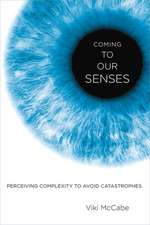Spatial Representation: From Gene to Mind: Developmental Cognitive Neuroscience
Autor Barbara Landau, James E. Hoffmanen Limba Engleză Hardback – 18 oct 2012
Preț: 689.82 lei
Preț vechi: 1042.11 lei
-34% Nou
Puncte Express: 1035
Preț estimativ în valută:
132.00€ • 141.15$ • 110.06£
132.00€ • 141.15$ • 110.06£
Carte tipărită la comandă
Livrare economică 07-14 aprilie
Preluare comenzi: 021 569.72.76
Specificații
ISBN-13: 9780195385373
ISBN-10: 0195385373
Pagini: 392
Dimensiuni: 236 x 160 x 25 mm
Greutate: 0.73 kg
Editura: Oxford University Press
Colecția OUP USA
Seria Developmental Cognitive Neuroscience
Locul publicării:New York, United States
ISBN-10: 0195385373
Pagini: 392
Dimensiuni: 236 x 160 x 25 mm
Greutate: 0.73 kg
Editura: Oxford University Press
Colecția OUP USA
Seria Developmental Cognitive Neuroscience
Locul publicării:New York, United States
Recenzii
Spatial Representation: From Gene to Mind is an important and scholarly book for anyone with an interest in Williams syndrome or for researchers who are interested in finding a model of how to investigate cognitive impairment. Landau and Hoffman do an excellent job integrating the findings from their laboratory with those of other researchers to provide a comprehensive analysis of the cognitive profile associated with Williams syndrome. The book is especially well written and organized ... I would highly recommend the book to anyone with an interest in understanding contemporary research in cognition.
Notă biografică
Barbara Landau is a cognitive scientist who works on the representation of space and language and the mapping between the two systems. She has carried out work on normally developing children and normal adults, as well as children and adults with neurological impairment, including people with Williams syndrome. Before coming to Johns Hopkins University in 2001, she held faculty positions at Columbia University, University of California-Irvine, and the University of Delaware. In 2009, she was named a fellow of the John Simon Guggenheim Foundation and the American Academy of Arts and Sciences. She is also a fellow of the American Association for the Advancement of Science, the Cognitive Science Society, the Association for Psychological Science, and the American Psychological Association. James E. Hoffman is a Professor at the University of Delaware. He works on visual representation, especially the nature of attentional mechanisms in the brain, using traditional experimental methods as well as event-related potentials in the brain to measure attention. He is a fellow of the Association for Psychological Science.















